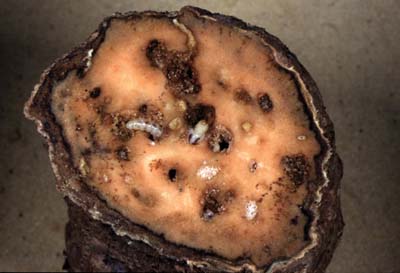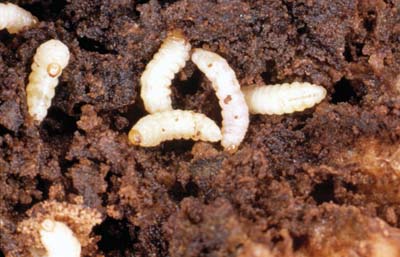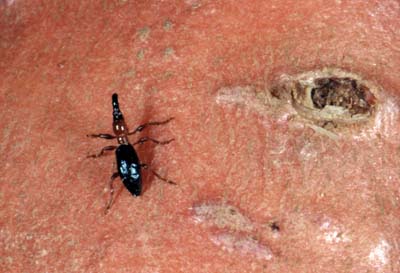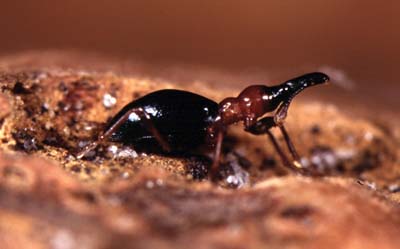Sweetpotato Weevil, Cylas formicarius
(Coleoptera: Curculionidae)
The sweetpotato weevil is found throughout the coastal plain of the southeastern United States and is also commonly found throughout the world in tropical regions. The life cycle requires one to two months with 35 to 40 days being the common requirement during summer months. The number of generations that may occur is indistinct but is usually estimated to be from five to eight. Adults do not diapause during the winter but rather seek shelter and remain inactive until the weather is favorable. Eggs are deposited in small cavities made by the female in sweetpotato roots or stems. One egg is deposited at a time. Eggs are usually deposited near the area where the root and stem connect. The egg is oval in shape and creamy white. The white larva burrows into the tuber or stem of the plant. The larvae will create winding tunnels in the root or stem that are packed with fecal material. As the larva matures, it will create a small chamber in the tuber or stem. The adult emerges from the pupation site by chewing a hole through the exterior of the plant tissue. The adult is rather ant-like in appearance with the head being black and the middle of the body being orange and the rest of the body being metallic blue. The snout is curved and is usually about as long as the middle of the body. Adults are capable of flight but dispersal patterns are rather limited in nature.
The sweetpotato weevil generally feeds on plants in the genus Ipomoea. Sweetpotato weevil is often considered to be the most economically damaging pest of sweetpotato with losses being recorded up to 97%. When sweetpotato is infested, the vines will usually turn yellow and may wilt. The sweetpotato weevil also causes indirect damage by facilitating entry of soil-borne pathogens. Several natural enemies are known including parasitoids and predators. Fungal pathogens have also been observed but research on biological control agents is limited. Management of the sweetpotato weevil may be achieved culturally by isolation, sanitation, and crop rotation. Adults are effectively monitored with pheromone traps. An insecticide should be applied according to the results of the sampling techniques used. Insecticides may be applied to the soil at planting or to foliage.
Images
To save the Web-optimized images shown below to your hard drive:
PC users: right click to "Save Picture (or Image) As..."
Mac users: click and drag to your desktop.
Copyright © 2005 University of Florida




